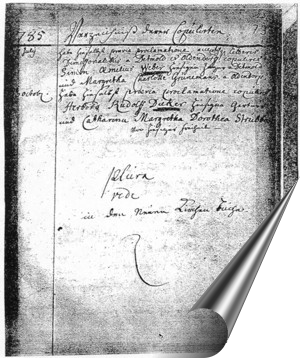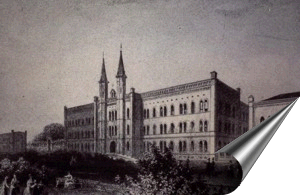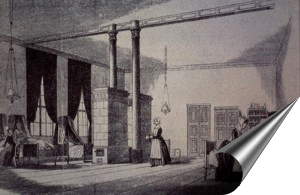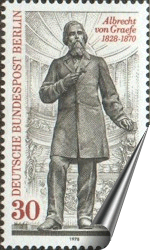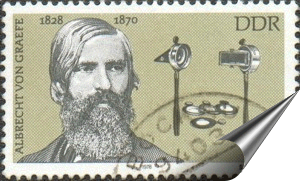Antonius Holtmann
Bohmte - Bremen - Public Landing.
A Success Story in 19th Century Cincinnati: A Genealogical Reconstruction
"Not the life we have lived
is life, but what we remember
in order to talk about it.”
Gabriel
Marcia Marquez
In
April 1834 Gottfried Weber from Barenau near Engter in the Osnabrueck
area went "towards America with little money in his pockets". In 1877
he had written down a 'short description' (“Kurtze beschreibung”) of
his life in a small leather-bound booklet intended for his nephew in
Germany.
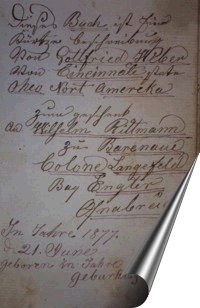
The
selective data and interpretations provided in this life story reflect
the author's personal attributions of meaning and the significance he
ascribes to events in his life. In retrospect Gottfried Weber
reconstructs his life: his childhood in a tenant's cabin, 10 years of
travelling as a baker's journeyman in Germany and The Netherlands, his
time as a worker at the canal in Fort Wayne/ Indiana and later on in a
quarry, his work in a flourishing hardware store in Public Landing on
the Ohio river, the vineyard he managed for 5 years and finally the
set-up of his own business on Main Street. According to the records of
the population census Weber's assets amounted to $ 5,500 in 1860. After
the Civil War (1861-65) Weber indicated in 1870 that his assets
totalled $ 240,000. He had profited from the increasing needs of the
rapidly growing city – and from the needs arising from the Civil War.
The
non-involved biographer who looks upon past events as an outsider,
seeks to reconstruct the past by blending his presentation with the
version given by the writer of memoirs. He is particularly interested
in data which the self-biographer did not perceive in his immediate
surroundings and therefore did not recount them. For this reason a lot
of information is lost for good; some information can be easily
regained – other only by making an effort. And in all cases the neutral
biographer is confronted with the task of deciding about how far the
range of the contextual network should be extended, about which
information can be interrelated and about the level of significance
that should be given to the links established. G. Weber's “short
description” provides starting points for this.
The
thrilling, however occasionally exhausting, endeavour of producing a
genealogical-biographical edition will be outlined in this paper; in
this edition the peasants' letters (
Antonius
Holtmann (Hg.):Ferner thue ich euch zu wissen…Briefe des Johannes
Heinrich zur Oeveste aus Amerika 1843-1876. Bremen: Edition Temmen 1996; currently out of stock; a complete version .
is available online.) and the soldier's letters (
Antonius
Holtmann (Hg.): Für Gans America Gehe ich nich Wieder Bei die
Soldaten….Briefe des Ochtruper Auswanderers Theodor Heinrich Brandes
aus dem amerikanischen Bürgerkrieg 1862/63. Bremen: Edition Temmen 1999)
will be supplemented by Weber's memoirs of his life as a merchant. This
edition is designed to encourage all those concerned with genealogical
reconstructions to cautiously go beyond the boundaries of what is
already known. The French historian Alain Corbin has shown that this is
possible even in those cases in which only a few official data are
available (
Auf den Spuren eines Ungekannten. Ein Historiker rekonstruiert ein ganz gewöhnliches Leben. Campus: Frankfurt/New York 1999).
Why did G. Weber go 'towards America' ?
G.
Weber was born in 1803 in a tenant's cabin in Barenau near the villages
of Engter and Kalkriese. This area is historically significant because
Hermann the Cheruscan and his Germanic army may have wiped out the
Roman troops in the Battle of Varus in 9 AD (
www.kalkriese-varusschlacht.de;
www.arminius-varusschlacht.de).
This disastrous battle which was actually a 'massacre' is still being
laboriously reconstructed on the basis of archaeological finds. It
reminds me of Alain Cobain's successful attempt to spot the Community
of Origny-le-Butin and Louis-Francois Pinaget (20 June 1798 -31 January
1876) in the records of the Registry Office of the French Department of
Orne "with closed eyes". In contrast to G. Weber, Pinagot had not left
behind any documented trails and definitely not a “short description”).
It
seems that G.Weber's birth – along with some other dates within a
specific period - was not entered in the church records of Barenau or
Engter. The last but one entry in the 'Register of Copulated Pairs' is
the marriage of Weber's parents Simon Amelius Weber and Margrethe
Charlotte Grünemanns on July 7, 1785. Data about Weber that have not
yet been acquired include: the Records of Confirmands, data on the time
he spent as a baker's apprentice in Minden, on his 10-year travels as a
baker's journeyman in Germany and in The Netherlands and data on the
time he worked as an administrative officer in Bohmte.
We don't know why G. Weber went 'towards America' 'with little money in his pockets but was always of good cheer'.
The framework conditions can be easily outlined:
- At
around 1834 the price of rye fell. This probably had bad implications
for Weber's rural employer and thus possibly also for his estate
manager.
- The price for
linen and production costs rose again slightly in the period 1831-1834.
Thanks to the Napoleonic Wars the price of linen per 100 m had risen to
28 thalers in 1815. By 1829 the price had dropped to 14 thalers for 100
m of linen and by 1834 the price had again risen slightly to 17 thalers
– with a tendency to rise. It can be assumed that G. Weber followed
these developments with distrust just as we follow the stock exchange
rates.
- Compared to the
years around 1820 the 'Hollandgängerei' (work as a seasonal worker in
The Netherlands on a regual basis ) earned German labourers 50% less in
the late 1820. In 1833 they earned as little as 12-16 thalers.
According to a report issued by the municipality of Vörden, this was
'very little, even less than in one of the past few years'. Although
Weber was not affected by this, it can be assumed that tese
developments did not encourage him to stay in a country which could no
longer provide for an increasing number of people.
- The
division of the Marches (around 1800), i.e. the distribution of
community in favour of peasants, deprived many tenant farmers of the
opportunity to keep some sheep or a cow. This did not affect G. Weber
either, however it might have strengthened his decision to leave the
country.
- In the
congregation of Bramsche, for instance, the number of births started to
exceed the number of deaths since the middle of the 18th century. This
trend increased by the turn of the century. Constantly rising numbers
of farmhands, maidservants and tenant farmers entered the rural, still
static labor market. Those who did not find an employment as a tenant
farmer or who had no roof over their head, were not allowed to get
married in the Region of Osnabrück (“Landdrostei Osnabrück”). In 1857
the writer Fritz Reuter (from Stavenhagen in Mecklenburg) summed up this situation in “No Home” (“Kein Hüsung”) in Low German:
„Heww`n up den Harwst wi
noch kein Dack, “If we don't have a roof over our head
Denn treck wie furt mit Sack un Pack,
in fall, we
will move away with bag and baggage,
Denn treck w` de Kramersdörper nah,
and we will
take those from Krämersdorf along
Denn gahn wi nah Amerika.“
we will go to America.”
- In
the region of Osnabrück these economic and social changes which are
widely viewed as the reasons that induced people to emigrate, hit
a population whose proportion of landless households, i.e. of tenant
farmers, had risen drastically after the end of the 30-year war,
whereas the number of big farmers had remained more or less unchanged.
In general the farms in this area were owned by noble or parochial
landlords. Only after 1831 was it possible for the peasant families
(colonen) who managed the farms as hereditary tenants, to gradually buy
their freedom from the landlords. Tenant farmers lived in poor, small
cabins which were built on the premises of the farmers after the model
of the big farm houses.
- The contracts between the
farmers and their tenants, which had to be renewed every year, stated
that thee tenants had to produce a certain output level which the
farmer could reduce or raise at will. At the time it was prohibited by
law to divide the farm; either the eldest or the youngest son was
entitled to inherit the farm; daughters were in second place: This
legal tradition which supported the interests of the squires and later
on was also maintained by the independent farmers, brought about the
phenomenon of the "downward mobility", i.e. the rising level of poverty
in rural areas. Daughters and sons of farmers who were not entitled to
inheritance/had not married a farmer and therefore had to work to make
a living as well as the fact that an increasing number of people
survived childhood as a result of better medical treatments, resulted
in a rising number of farmhands, maidservants and tenants. Jürgen
Schlumbohm analysed this phenomenon in an exemplary study (Lebensläufe,
Familien, Höfe. Die Bauern und Heuerleute des Osnabrückischen
Kirchspiels Belm in proto-industrieller Zeit, 1650-1860. Göttingen:
Vandenhoeck 1994).
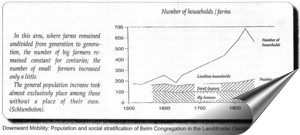
Social
structures and institutions may definitely be regarded as factors which
induced people to emigrate. But although many people were affected by
those factors, not all of them emigrated. It appears that the decision
to emigrate is made at a very personal level. It is difficult to
determine to what extent prevailing structures (e.g. sovereign
authorities and ownership conditions), existing institutions (e.g.
administrations, legal regulations and specific behavioral traditions)
and personal situations (including coincidental factors like
preferences, crop failures) impacted the decision to emigrate. This can
only be reconstructed in retrospect, influenced of political and social
theories. If it is assumed that mostly existing structures induced
citizens to leave the country, emigration is primarily viewed as forced
behaviour. If, however, the personal motives of those leaving the
country are viewed as the main reason for emigration, the emigrants are
looked upon as independent citizens who make their own decisions. Those
who believe that existing structures and institutions made many people
leave their home country, generally have a wider knowledge of
prevailing conditions than those who are directly affected by them.
Those who believe that the people who emigrated mostly did so for
personal reasons, are not entirely sure about this, especially because
most emigrants have only provided little information about what
actually made them leave the country.
What the “short description” (“Kurtze beschreibung”) provides
G.
Weber did not specify his reasons for emigrating. Purposefully he and
his co-travellers from Bohmte and its surroundings set off to Fort
Wayne, a small place in the boondocks of north-eastern Indiana where
thousands of people found work in channel construction which had just
been started.
 | Weber' report on this period can only be complemented by referring to
some insufficient data that are available about this time span. The information
on emigration in the year 1834 provided by the authorities of the
Wittlage-Hunteburg County (“Bericht des
Amtes Wittlage Hunteburg, den 15ten November 1834, betreffend die Auswanderung
nach Amerika im Jahre 1834”) only includes figures, but does not give any
names: in total 275 people left the area in 1834, among them 60 single men, 11
single women and 49 families with 204 members. The authorities of the
Wittlage-Hunteburg County estimated that the "rough capital assets"
which the emigrants took away to America amounted to 27,506 thalers. (State
Archive, Osnabrück)
G. Weber indicated that he paid
45 talers for the passage to America. In an advertisement publihsed in the “Osnabrückischen Öffentlichen Anzeigen"
on February 12, 1834 the "Schiffsmärkler J.D. Lüdering" stated an
average price of 38 gold thalers. We don't know who else travelled to America
on board the "Eleonore&Henriette" along with G. Weber (It seems
that the passenger list is no longer available.) but from a report that appeared
in the "Oldenburgische Blätter"
on March 10, 1835 we know that 100 people were on board the brig
"Eleonore&Henriette". The report states that the vessel had left
Bremerhaven on April 20, 1834 and had arrived in New York on May 23rd.
40 years later G. Weber remembered that "80 people without children
from Bohmte alone" had gone to America with him. They had left the place
"on Easter Monday (March 31, 1834)…. accompanied by music".On the eve
of April 10, 1834 G. Weber saw the "Shenandoah" which had run aground
in the mouth of the Weser river. It appeared that no help was provided. He
presumed that 125 passengers died in the accident but according to the
“official in charge at Bremerhaven” 162 of the 192 passengers were rescued
(Bremen State Archive).
In New York they boarded a ship up the Hudson river to Albany, then on
the Erie-Canal (83 locks) boarding tow-boats up to Buffalo at the bank of the
Lake Erie, and from there crossing the lake to Toledo and with canoes or
pirogues up-stream the Maumee river to Fort Wayne.
In Fort Wayne no trace
has been found of G. Weber and no information can be found on his co-travellers
either because the passenger list giving their names is no longer available.
The first German Lutheran community was not set up until in 1837 and neither newspaper
articles nor community records do provide any information on the immigrants
from Bohmte. |
In
his report G. Weber mentions hard work which is only poorly paid and
many of his fellows from Bohmte died of a fever. These statements are
endorsed by letters written by an Anglican priest who also mentioned a
number of deaths, but dismissed the possibility that the people in Fort
Wayne died of the Cholera epidemic that was raging in the country at
the time. Weber also fell ill and only recovered slowly. Eventually he
found work in a canteen. In the fall of 1834 he went to Cincinnati.
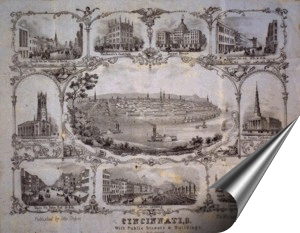
This
city was viewed as the tempting "queen of the West" on the Ohio. For
many it was the starting point from where many set out to finally
settle in Ohio, Indiana or Illinois – the states that formed the
Western frontier at the time because the West ended at the Mississippi
river. Behind this river was the land the Indians had been promised
("for as long as the grass grows and the waters flow"). In 1830 5% of
the 24,000 inhabitants of Cincinnati were of German origin. By 1850
their number had risen to almost 50,000 out of about 160,000. G. Weber
found work in a quarry and a short time later he worked at
Shoenberger's hardware store at Public Landing – the 'harbour' area of
Cincinnati. The Shoenberger family was first class in Pennsylvania's
steel industry which was based around Pittsburgh and was now opening up
the blossoming markets down the Ohio and the Mississippi river up
to St. Louis and Memphis. For 20 years G. Weber held the function of a
chief 'assistant' to this branch of the German-American Shoenberger
family. Soon after he had taken up his job there he managed the
Schoenberger's business affairs at the lively public landing, he went
hunting with his employer and his children.
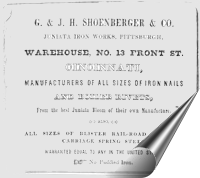
He
saw the construction of the Shoenberger manor (1867 at 440 Lafayette
Avenue at Clifton, now “Scarlet Oaks Retirement Community”:
http://scarletoaksretirementcommunity.com)
with its unhindered view of Spring Grove – the graveyard of
Cincinnati's upper middle-class whose members did not belong to the
church. This graveyard had been designed as a park by Adolph Strauch
(1822-1883), a landscape gardener from Silesia who was supported by the
Prince of Pückler. This 'gardener', who had learnt his profession by
designing the parks of Muskau and Branitz, also designed the
surroundings of Shoenberger manor.
December 5, 1880 the Cincinnati Enquirer reported: “Mr. George H. Shoenberger, a retired ‘Iron
King’, who lives in a palatial residence at Clifton, is rated at $ 5.000.000”. The New York Times, December 10, 1870
reprinted this information. “CINCINNATI`S RICH MEN. SOME OF ITS CITIZENS WHO
ARE CREDITED WITH THE POSSESSION OF MILLIONS”.
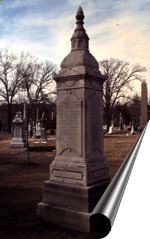 | As
early as in 1873 Gottfried Weber purchased a grave for $ 470 for his
entire family in Spring Grove and put an obelisk (Greek for 'small
skewer’) on it which was 20 feet tall and cost $ 1,500. "After death
everyone will forget and that is just as well. But I think that I have
left [my family] something to remember. Therefore I bought this place
and set up a nice tombstone…". In doing so G. Weber had bought himself
into the upper middle-class. ( www.springgrove.org/Cemeteries.shtm
> locate
a Loved One > Search By Name: First Name: Gottfried; Second Name:
Weber > ID 49338. - Or to the family grave:
Search By Location: Garden: Land; Section, 14; Lot: 7)
G.
Weber deals rather harshly with his family. He mentions a quarrel with
his sons: “When the children were small it was a pleasure having them,
when they were men it was a displeasure”.He also mentions a quarrel
with his wife. She had never been a "support" to him. "What has been a
burden, continues to be a burden". |
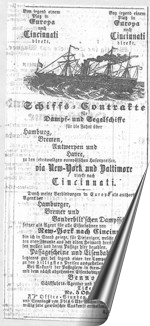
G.
Weber reports that he visited the Osnabrueck area in 1860 but that he no longer
felt good there. Very probably he arrived at New York July 26, 1860, boarding
the ship “Bremen”, the first steamer of the Norddeutscher Lloyd. The passenger
list has the steerage passenger “Gottf. Weber, 46 years, farmer, Cincinnati” (National Archives, Washington D.C.: Original
New York Passenger Lists). He had leased his “Vineyard” (See the next but
one paragraph.) since 1859, but not yet sold (1862). Farmer was a reputable
profession. Leaving Bremerhaven (July 7, 1860) he was 56 years old. The list
offers “46”. It could be a mistake in hearing or an oversight, or he
rejuvenated himself.
However,
he felt good when he was in Berlin in 1867 when he stayed in the 'Haus
Bethanien', a hospital in the Kreuzberg district that was under royal
protection run by deaconesses (now:
www.kunstraumkreuzberg.de).
Albrecht
von Graefe (1828-1870) Berlin's famous eye specialist who treated the rich as
well as the poor (He was the first to operate eye cataracts.) had treated
Weber, and “Sister Julie” had nursed him and had “saved his life'”. He
presented her with a golden watch – which was tolerated contrary to existing
regulations – and he was officially bidden farewell during a church
service. - We found his passenger list: leaving Bremerhaven August 11,
1867, he arrived at New York August 29 on board of the American paddle-steamer
“Northern Light”, together with his son Wilhelm. (National Archives, Washington D.C.: Original New York Passenger Lists). The passenger list reports,
that Gottfried Weber was “60” years old. Leaving Bremerhaven (August 10/11,
1867) he was 64 years old.
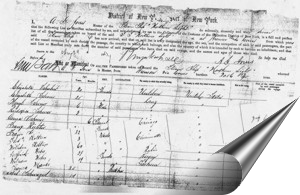
Weber also mentions a "vineyard" which he had owned between
1850-1862 and had sold with a profit (of $ 2000) although the vine pest had
ruined the experiment of growing wine on the Ohio river some Germans had
engaged in. Fortunately the pest did not cross the Atlantic Ocean and spread in
Europe.
After this short
intermezzo Weber reverted to the hardware business, just in time before the
Civil War (1861-1865) broke out. Now he ran his own store which was located in
a convenient place (on Main Street), not far from the German quarter "Over
the Rhine" (north of the soiled Miami-Erie Canal) and very close to the
state of Kentucky, a state which did not take sides in the Civil War and was
famous for trading and bootlegging: "You have to make hay while the sun
shines". His reward was a heavy toll. The 1860 Census reports $ 15.000
value of real estates and $ 500 value of personal estates, the 1870 Census $
40.000 respectively $ 200.000 (National
Archives, Washington D.C.: Census 1860, 1870).
In 1862 he had his own hardware store at 360 Main Street, between 8. and 9. Street (now Central Parking:
http://maps.google.com
>
Satellit > Street View: 842 Main St.,
Cincinnati, Ohio, Hamilton, United States). In 1863 he bought this site (Store and home) and
paid $ 1.500 (Hamilton County Courthouse:
Deed Book). In 1865 Williams’
Cincinnati Directory has this notice: “Weber & Co., (Gottfreid W. &
Geo., W. W. W.), Dealers in Hardware, Iron, Nails and Steel, 360 Main”. In 1867
his sons Wilhelm, Martin and George have the store, and they buy the site Main
/ 9. Street. In 1914 their heirs sell it to The Second National Bank for the
amount of $ 20.000 (Deed Book). The
building is still there (
http://maps.google.com
>
Satellit > Street View: 872 Main St.,
Cincinnati, Ohio, Hamilton, United States). 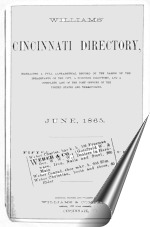
In
1864 Gottfried Weber bought 2 residences, close to the store, 8. St. (No. 14/16
West), between Main and Walnut, not in the German quarter “Over the Rhine”
(north of the soiled Miami-Erie Canal), but downtown in an Anglo-Saxon
neighbourhood. He paid $ 13.000 (Deed
Book): “The business was good and we made a lot of money”. Not infrequently
pretty often he may stopped for refreshment together with customers at Simon
Arnold’s Saloon, since 1861 at 8. St., (now 210 East), within walking distance
to his store and his home. The building and it’s furnishings are still much the
same as in 1861 (
www.arnoldsbarandgrill.com).
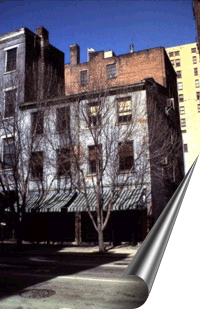
Everyday
life in Cincinnati is disregarded in Weber's written accounts. He does not
mention his service as a firefighter, the riots against the Irish and the
Germans staged by native Americans who opposed mass immigration by poor and
very poor Europeans and he does not mention the Democratic Party's opposition
to the war either. In his description he verbally attacks the Party but these
attacks are actually targeted at the party's Catholic clientele. Weber sided
with Abraham Lincoln and the Republican Party: - he became a rich man.
What the “short description” (“Kurtze beschreibung”) does not provide
The
facts that are presented in the following either did not cross Weber's
mind in 1877 or he kept quiet about them for good reasons. We do not
know about this.
As regards his tax payments, for example: It must be stated that
no trace of them was found in Cincinnati. They may have been lost in the
burning of the Hamilton County Courthouse in 1884 when a raging mob stormed the
building after a supposed racist judgement in a murder trial had been rendered
in favour of a German citizen.
Weber's wedding, for example: On
February 27, 1835 Weber married Cathr. Elisabeth Boje who originated from
“Herde (?) near Osnabrück”. It can be assumed that he already met her in
Germany because he married her shortly after his arrival in Cincinnati in St.
Johannes, a German Lutheran and Reformed Church. They did not 'have to marry':
Their eldest son, Martin, was not born until February 15, 1836.
Weber's
founding of a congregation, for example: Weber was one of those who founded the Lutheran
“Low-German Church” (vernacular), i.e. the “North German Lutheran Church”
(Walnut St. / 9. St.; not preserved) that had emerged from the “German Lutheran
and Reformed St. Johannes congregation” (Since 1868 Elm St. / 12. St.: http://maps.google.com
> Satellit > Street View: 1222 Elm St., Cincinnati, Ohio, United States):
"Owing
to the dispute of 1838 … no one can be elected to the consistory who is
not able to speak Low German", the founding fathers stated in their
'Constitution'. The congregation of St. Johannes responded immediately
by revising its 'Constitution' in 1839: "To preclude any provincial
prejudices, the parish considers it necessary to only elect 3 members
from one province to the consistory. But all North Germans together
only form one province”.
In
1845 Weber once again gets involved when more liberal church members separate
from the North German Lutherans: "§2: The owners of the church call
themselves: ‘German Evangelical Congregation of St. Paul’. They may either avow
themselves to the Lutheran or to the Reformist Church". In his description
Weber does not comment on his activities as a keeper of finances in the
consistory. In 1850 he voted against a new church building (Since 1851 Race St.
/ 15. St.: http://maps.google.com
>
Satellit > Street View: 1448 Race St., Cincinnati, Ohio, United States). He went back to St. Johannes: In 1890 his name is in the register of deaths of this congregation (September 29, 1890).
Weber's
founding membership in the "German Pioneer Association of Cincinnati”
(“Deutscher Pionier-Verein von Cincinnati” (1869), for example (online)
For several years Weber was the treasurer of this association. The
publication regularly issued by the association was "Der Deutsche
Pioneer". These 18 volumes provide ample information on the
history of the first German immigrants in the Mid-West. § 2 of the
'Constitution' states that "Every German immigrant who has lived for at
least 25 years in Cincinnati or its surroundings and has reached the
age of 40 can be admitted … if the members approve by popular vote."
Because of this stipulation the German 48ers who were considered
armchair culprits by many farmers, craftsmen and traders, could not
join the association – at least not for a period of 4 years:
"Oh yes, promote German customs!
Neither politics nor religion
Should ever be the warriors' motive to fight
or the matter of discussion.
No, Strengthen close ties!
Happily link them up with your experience!
The shout rings out far and wide all over the country:
Hurrah to the German Pioneer Association!"
(“Ja fördert Ihr die deutsche Sitte!
Nicht Politik, nicht Religion
Sei jemals in der Kämpen Mitte
Der Gegenstand der Discussion.
Nein! Festigt enge Bande!
Webt das Erlebte froh hinein!
Weit klingt der Ruf im ganzen Lande:
Hoch deutschem Pionierverein!“)
Weber's American version of the "Song from America” (“Lied aus Amerika”), for example: In 1875 Weber read out the "Song from America" to the Pioneer Association (online):
“Hail to Columbus, be praised,
Be greatly honored for ever!
You showed us a way which can free us
From severe bondage, if we dare
To renounce our home country.”
(“Heil Dir Columbus, sei gepriesen,
Sei hoch gelobt in Ewigkeit!
Du hast uns einen Weg gewiesen,
Der uns aus harter Dienstbarkeit
Erretten kann, wenn man es wagt
Und seinem Vaterland entsagt.“)
In
February 1833 nearly identical 49 stanzas of this song (online)
circulated in the Osnabrück area: It was supposedly composed by "Franz
Lahmeyer" under the title "Sinnreiche Einfälle in Stunden froher Laune
über mein Vaterland Europa verglichen mit den vereinten Amerikanischen
Staaten, gewidmet für meine europäischen Freunde im Königreich Hanover"
(“Meaningful ideas in times of high spirits on my homeland Europe
compared with the United States of America, dedicated to my European
friends in the Kingdom of Hanover”). The "land dragon Lange" told his
colonel that the song spread particularly widely in the
“Wittlage-Hunteburg County", that it described "the major advantages of
America over the German constitution" and that it could only be used to
stir civil unrest … or it could be intrepreted as an encouragement to
leave one's home country because the current spirit of the time
(“Zeitgeist”) (was) particularly susceptible to something like this".
In May 1833 the "British-Hanovarian Ministry of the Interior" responded
to this in an unperturbed manner: On occasion the poem was to be
"confiscated" and then “the owners of these verses are to be informed
in a suitable way about its shameful content and negative notion"
(State Archive, Osnabrück). "But when printed copies were no longer
available, several hundred copies were written secretly and whenever
the blokes in the pubs were sure that they were not under observation
by the police they started to sing: Hail to Columbus, Columbus be
praised."
This is what
Heinrich Arminius Rattermann, “editor” of the “German Pioneer”, who
originated from Ankum (Landdrostei Osnabrück), wrote when he published
G. Weber's "only available specimen, obviously [copied] with errors,
with minor changes in order to make it easier to sing, however without
changing its original tone". The "poem" which is "extremely inadequate
in terms of orthography and syntax" is to have "induced many young
people from the Oldenburg and Osnabrueck area to emigrate in the
1830s". Rattermann wrote that Franz Joseph Stallo from Damme, who got
this song from a friend in America in 1831, distributed the poem. After
some months in jail, Rattermann wrote, he emigrated to the USA in the
fall of 1831, arriving at Philadelphia. But we know that he left
Germany at the end of April 1831 with the ship “Juno”, arriving at New
York June 22, 1831 (National Archives Microfilm Publications, M 237,
Roll 14). G Weber brought one copy of the poem to America where he kept
it for 40 years. It could have been a copy of the Stallo-song or a copy
of the Lahmeyer-song
(online).
Orbituary
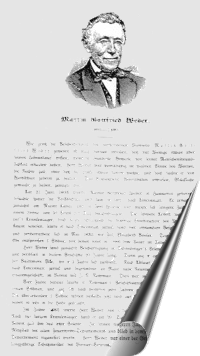 | G.
Weber chose to cover other topics in his “short description” ("Kurtze
beschreibung") and emphasized other aspects than those stressed in the
obituary about him which the German Pioneer Association published in 1890, at a
time when “Der Deutsche Pionier” no
longer appeared on a monthly basis but was issued as a yearbook (“Vorstandsbericht”).
Martin Gottfried Weber
1803 - 1890
How modest the late pioneer Manfred Gottfried Weber
was may be derived from the fact that only few people knew something about his
life course and yet hundreds of them experienced proofs of his philantropy. Mr.
Weber was charitable in the truest sense of the word. The right and gave and
the left hand didn't know and he tried to keep his benevolence a secret. It
sufficed him to know that he had done good and to have made others happy.
Manfred Gottfried Weber was born in Hannover on 21.
June 1803; later on he attended primary school (“Volksschule”) and in 1821 he
went to Cincinnati. At first he worked on the Miami Canal and in Fort Wayne and
for a long time he had to live on a wage of 50 cents per day. The hard work he
did made him sick but eventually the patient' his strong constitution
prevailed. Barely recovered he returned to Cincinnati where he found a more
profitable job and in May 1835 he married Miss Elisabeth Boeser. Three sons
issued from this happy marriage, one of whom preceded his father in death in
1886.
At first Mr. Weber found a job at Schönberger's
hardware store where he worked for 20 years. Then he moved to a farm on
Baltimore Pike where he lived for five years. After this time he returned to
Cincinnati where he set up his own hardware store on Main [Street] near Ninth
Street, together with J.N. Newman. This occurred in the year 1862.
Four years later he bought Newman's share of the
company, associated with one of his sons and after another ten years he
completely retired from business. The 2 sons who survived him managed the
business, which was still located in the same place and they were quite
successful.
In 1883 Mr. Weber celebrated his Golden Wedding
Anniversary which was a rare occasion at the time. After a short illness he
died on 29. September 1890 and the Pioneer Association paid him their last
respects. In his younger years he was an avid member of the old fire-brigade
department and continued to be a member until the present department was set
up. Mr. Weber ws one of its founders and he was the first long-term treasurer
of the Pioneer Association.
(Vorstandsbericht des Deutschen Pionier-Vereins 23
(1890/91), 16; translation)
Different
pictures are painted although the same data were used. It seems that in
retrospect but also by lack of knowledge many things were distorted. As regards
the time of Weber's emigration (1834, and not 1821!), for instance, he did not
go first to Cincinnati, but to Fort Wayne. And he married in February 1835 and
not in May of that year (Family register, St. Paul, 1845). The maiden name of
his wife-to-be was not Boeser but Boje. And it was not a happy marriage
tie. And his service of a firefighter lasted only from January 1844 to April
1846. He was “afflicted with a disease in his chest” (Cincinnati Museum
Center). | 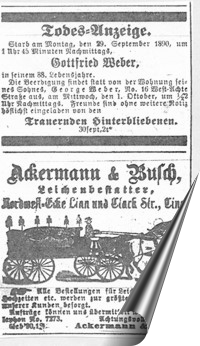 |
A final remark
This
report produced in my 'workshop' may have given one or the other an
idea of how far the contextual range of Gottfried Weber's life can be
extended. It allows for different combinations of the threads of his
life as well as for giving different levels of significance to decisive
incidents in his life. In addition to this, a wide contextual range
also provides the basis for presenting different life portraits, i.e.
different constructions of his life. Hence it seems advisable to use
the subjunctive tense in memoirs, obituaries or biographies in order to
illustrate the tentative nature of what is said.
I wrote
this report to point out how important it is to produce one's own
reconstructions – with the subjunctive tense at the back of one's mind
– sot that they can be used as a genealogical 'reservatio mentalis'.
| [This
delivery, now revised in 2010, has been published first in: Die Maus,
Gesellschaft für Familienforschung e. V. (Hg.): Genealogie und
Auswanderung: Über Bremen in die Welt; Grußworte und Vorträge zum 54.
Deutschen Genealogentag in Bremen. Clausthal-Zellerfeld: Papierflieger
2002, 59-70. The version of 2002 is available online: www.genealogienetz.de/vereine/maus/blaetter/dgt2002_seite_59-70.pdf. Documents,
which belong to this outline, are in the Research Center German
Emigrants in the USA (DAUSA). The “Kurtze beschreibung”, with an
introduction, profusely illustrated and with many notes, will be
published in the not-to-distant future. - Sabine
Osterkamp, Oldenburg University, translated this delivery.] |
